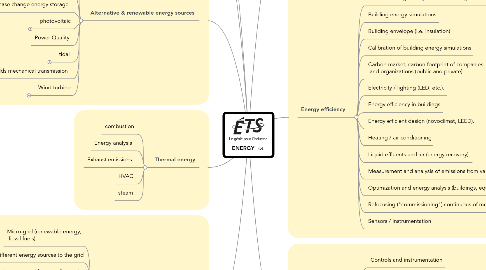
1. Combustion, Motorization, Engine
1.1. Cybernetic Transport System (Serpentine)
1.2. Diesel & Biodiesel
1.3. Direct injection engines
1.4. Exhaust emissions
1.5. Hybrid vehicles (PHEV, V2G)
1.6. propane engines
1.7. Spray & Jet Fuel
1.8. Turbines (biogas)
2. Energy efficiency
2.1. Artificial intelligence systems of building control
2.2. Building energy simulations
2.3. Building envelope (i.e. insulation)
2.4. Calibration of building energy simulations
2.5. Carbon market, carbon footprint of companies and organizations (public and private)
2.6. Electricity / lighting (LED, etc.).
2.7. Energy efficiency in buildings
2.8. Energy efficient design (novoclimat, LEED).
2.9. Heating / air conditioning
2.10. Liquid effluents and air (energy recovery)
2.11. Measurement and analysis of emissions from various energy sources
2.12. Optimization and energy analysis (buildings, equipment, machinery, processes)
2.13. Refocusing ("commissioning") continuous of mechanical systems
2.14. Sensors / Instrumentation
3. Power Electronics
3.1. Controls and instrumentation
3.2. Converting electrical energy
3.3. electrical machinery
3.4. electromagnetism
3.5. High Voltage
3.6. Lossless switching
3.7. Power discharge lamps (Laser, neon, LED, etc ...)
3.8. Power semiconductor (IGBT, MCT, etc.).
3.9. Real-time simulation of power systems
3.10. static converters
3.11. Supply at very high frequency
4. Researchers and departments involved
4.1. Departments
4.1.1. Department of construction
4.1.2. Department of Electrical
4.1.3. Department of Mechanical
4.1.4. Department of Software and IT
4.2. Researchers
4.2.1. Number of researchers "Core": 12 (researchers who have this area as a central research theme)
4.2.2. Number of researchers "No Core": 21 (researchers who participate in research projects may be related to this topic)
5. Chairs and research units
5.1. Research chairs
5.1.1. Industrial Research Chair in Technologies of Energy and Energy Efficiency – T3E
5.1.2. Hydro-Québec/TransÉnergie Chair on Simulation and Control of Electric Power System
5.1.3. Canada Research Chair on Electrical Energy Conversion and Power Electronics
5.1.4. Chair in Biofuel Combustion for Transport
5.2. Accredited research units
5.2.1. GREPCI – Power Electronics and Industrial Control Research Group
5.3. Research units recognized
5.3.1. CTT – Thermal Technology Centre
5.3.2. NEAT – Research Laboratory on the Nordic Environment Aerodynamics of Wind Turbines
6. Alternative & renewable energy sources
6.1. Bioenergy (gas, liquid, solid)
6.2. geothermal
6.3. Hybrid systems (combination of focile energy sources)
6.4. Hydrogen fuel cell
6.5. Phase change energy storage
6.6. photovoltaic
6.6.1. electromagnetic radiation
6.6.2. Solar radiation
6.7. Power Quality
6.8. tidal
6.8.1. hydraulic behavior
6.8.2. hydrological modeling
6.8.3. structure
6.9. Tree yields mechanical transmission
6.10. Wind turbine
6.10.1. Aerodynamics
6.10.2. composite structure
6.10.3. Power electronics (DFIG, PMSG and SCIG)
7. Thermal energy
7.1. combustion
7.2. Energy analysis
7.3. Exhaust emissions
7.4. HVAC
7.5. steam
8. Generation, distribution & transport of electricity
8.1. Micro-grid (renewable energy, fossil fuels)
8.2. Distributed networks: connecting different energy sources to the grid
8.3. Distribution systems (underground cables, transformers)
8.4. Electricity transport
8.5. Generation by combustion
8.6. Hydropower generation
8.6.1. Building
8.6.2. Hydraulic turbines
8.6.3. Implantation (Hydrology, hydrogeology, geotechnical, seismic protection, etc.)

